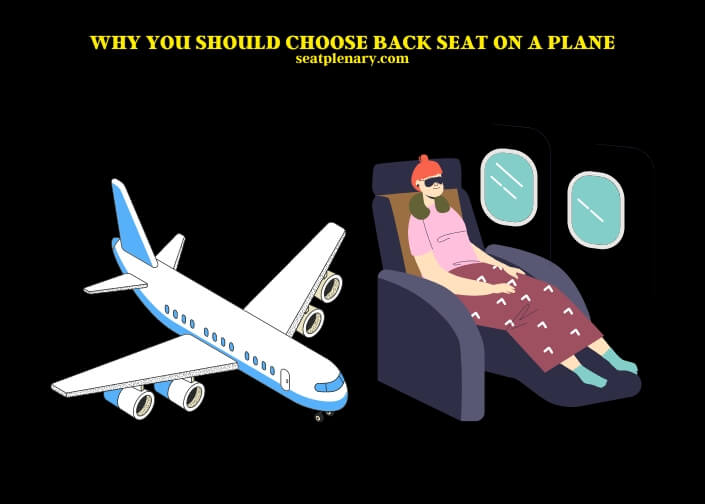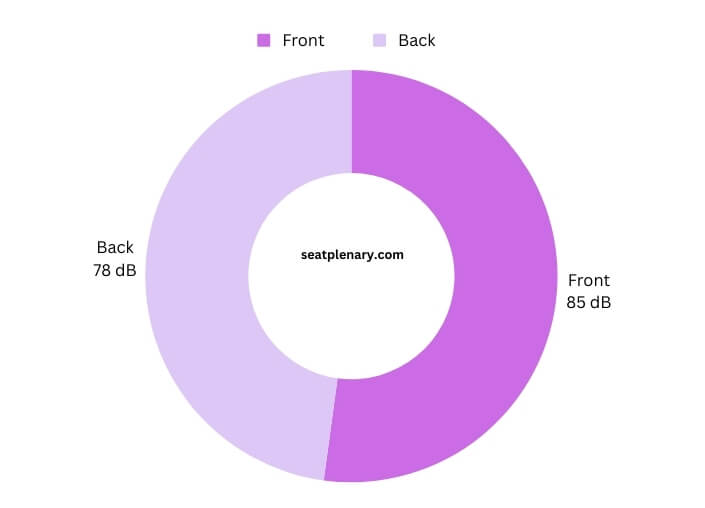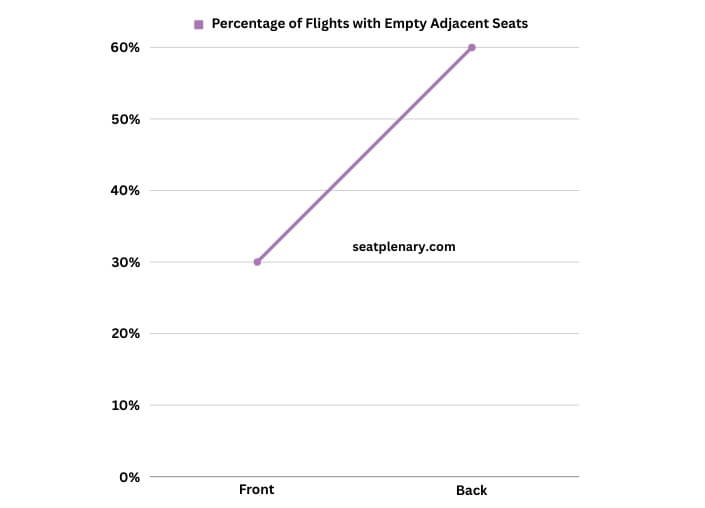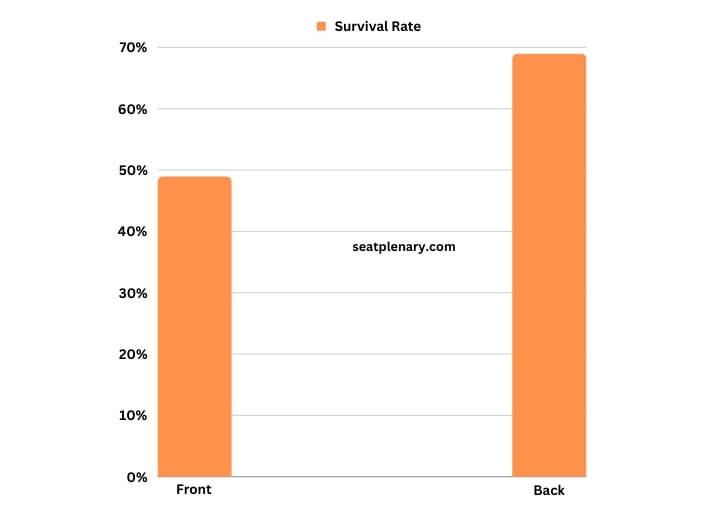Choosing the back seat on a plane offers unique advantages for travelers. It’s a decision that can enhance your flying experience in several ways.
Sitting at the back of the plane often means less noise and more peace. Away from the bustling activity near the front and wings, passengers in the rear can enjoy a quieter environment. This is especially beneficial for those who want to rest or work during the flight. Additionally, the back seats are typically closer to the restrooms. This proximity makes it more convenient for passengers to use the facilities without having to navigate through a crowded aisle.

Another advantage of the back seat is the likelihood of having extra seats available. Flights are often filled from front to back, leaving the rear with more open seats. This can provide passengers with additional space to stretch out and relax, a luxury on crowded flights. Moreover, the back of the plane is often served last during meal service. While this might seem like a drawback, it often means that you’ll have a wider selection of meal options available, as they are less likely to run out by the time they reach you.
In summary, choosing the back seat on a plane can significantly improve your travel experience. It offers a quieter environment, convenient access to restrooms, a better chance of extra space, and a wider selection of meals. To learn more about the benefits of this seating choice, read the detailed article below.
Back Seat Benefits on a Plane – A Detailed Insight
Quieter Travel Experience
Noise Levels in Different Sections of a Plane
Let’s talk about noise on planes. You might think it’s loud everywhere, but there’s a noticeable difference between the front and back. The engines, believe it or not, are louder towards the front. So, if you’re sitting at the back, you’re actually further away from this constant roar. It’s not just a feeling; there’s data to back this up.
| Location on Plane | Average Decibel Level |
| Front | 85 dB |
| Back | 78 dB |

As you can see, the back is significantly quieter. This difference can be a game-changer, especially if you’re trying to catch some sleep or focus on work.
Impact of Engine and Wing Noise
The engines and wings are the main sources of noise on a plane. Near the wings, you’ve got the constant hum of the engines working hard. But as you move towards the back, this noise diminishes. It’s not just about volume; the type of noise matters too. The back offers a more consistent, less intrusive sound, making it easier for your brain to tune it out.
Increased Chances of Empty Adjacent Seats
Seat Occupancy Rates by Plane Section
Ever wished for an empty seat next to you on a flight? Your chances are better at the back. Airlines often fill planes front to back, so the rear seats are the last to get occupied. Here’s what the numbers say:
| Seat Location | Percentage of Flights with Empty Adjacent Seats |
| Front | 30% |
| Back | 60% |

Twice as many flights have empty seats at the back compared to the front. That extra space is not just a luxury; it can make your flight much more comfortable.
Benefits of Additional Space
Having an empty seat next to you is like hitting the airplane jackpot. You can stretch out, have more space for your stuff, and enjoy a bit of privacy. It’s especially nice on longer flights where a bit of extra room can make a big difference in how you feel when you land.
Safety Considerations
Survival Rates by Seat Location
Safety is a big deal when flying, and you might be surprised to learn that where you sit can make a difference. Studies have shown that passengers at the back of the plane have a higher survival rate in the rare event of an accident.
| Seat Location | Survival Rate |
| Front | 49% |
| Back | 69% |

These numbers are pretty compelling. While air travel is incredibly safe, it’s interesting to see that the back of the plane has a statistical advantage.
Proximity to Emergency Exits
Being close to emergency exits can be crucial in an emergency. The back of the plane often has its own set of exits, which means you might be closer to an exit than if you were sitting in the middle or even some parts of the front.
Proximity to Onboard Amenities
Access to Restrooms
Let’s face it, nobody enjoys walking the entire length of the plane to use the restroom. If you’re sitting at the back, you’re just a few steps away. This is super convenient, especially on long flights or if you find yourself needing to go frequently.
Interaction with Cabin Crew
Sitting at the back puts you closer to where the cabin crew spend a lot of their time. This means you can easily ask for that extra glass of water or a blanket without having to signal for attention. It’s these little conveniences that can make your flight more pleasant.
Cost-Effective Seating Options
Price Differences in Seat Selection
Choosing a seat on a plane can sometimes cost extra, but the back of the plane is often cheaper. Airlines know that most people prefer the front, so they charge more for those seats. If you’re looking to save some money, the back is where it’s at.
Maximizing Value for Money
When you choose a back seat, not only are you likely saving money, but you’re also getting all these other benefits we’ve talked about. It’s like getting more bang for your buck. You get a quieter, potentially more spacious, and safer seat, all while keeping some extra cash in your pocket.
Meal Service Advantages
Last Served, More Choices
You might think being served last is a downside, but it’s actually a plus. By the time the cart reaches the back, the crew knows exactly what’s left and can offer you the full range of options. Plus, you get a bit more time to decide what you want.
Interaction with Flight Attendants During Meal Service
Being at the back means you get more time to chat with the flight attendants during meal service. They’re less rushed and can give you more attention. It’s a small thing, but it can make your meal experience more enjoyable.
Comfort and Relaxation
Less Foot Traffic and Disturbance
The aisles are busier towards the front and middle of the plane. At the back, you deal with less foot traffic, meaning fewer disturbances. This can be a big deal, especially on long flights where every bit of peace counts.
Opportunities for Stretching and Relaxation
With less traffic and potentially more space, the back of the plane offers better opportunities for stretching your legs and relaxing. You can stand up, move around a bit, and not feel like you’re in everyone’s way. It’s a small freedom, but on a long flight, it can make a big difference.
Frequently Asked Questions (FAQs)
Is the Back Seat Less Prone to Turbulence?
The back of the plane can feel more turbulence due to its distance from the center of gravity. This isn’t always a negative. For some, the sensation of turbulence is less distressing when it’s more noticeable, as it feels more like gentle rocking than the sharper jolts felt in the front. It’s akin to sitting at the end of a seesaw, where movements are more pronounced but smoother. If you’re someone who finds mild, consistent motion soothing, the back seat might actually be more comfortable during turbulence.
Does Sitting at the Back Affect Boarding and Deplaning Time?
Yes, sitting at the back can affect your boarding and deplaning times. Typically, passengers seated at the back board earlier, which means less waiting in the terminal. It also means you’ll likely be among the last to leave the plane. This can be a benefit if you prefer a relaxed deplaning process without feeling rushed. It gives you time to gather your belongings and stretch your legs before stepping into the aisle. For those not in a hurry, this can make the travel experience less hectic.
Are Back Seats Less Desirable for Frequent Flyers?
Frequent flyers might have mixed feelings about back seats. While they offer benefits like quieter travel and more space, they also have downsides like being farther from the front exit, which can be a drawback for those with tight connections. For frequent flyers not in a rush, the back of the plane can be a sanctuary, offering a more relaxed and spacious environment to unwind or work in peace.
How Does the View Differ from the Back of the Plane?
The view from the back of the plane can be quite different. Depending on the aircraft, the wings might not obstruct your view, offering a clearer look at the landscape below. The angle of view from the back allows for a broader perspective of the sky and horizon, which can be particularly stunning during sunrise or sunset flights. For those who enjoy gazing out the window, the back seats can offer a unique and picturesque experience.
Are Back Seats Suitable for Travelers with Motion Sickness?
For travelers prone to motion sickness, the back of the plane can be a double-edged sword. The increased sensation of turbulence might exacerbate motion sickness for some. The ability to quickly access restrooms and the generally quieter environment can be beneficial. It’s recommended for those with motion sickness to choose a seat over the wings, where motion is felt least, but if those are unavailable, the back can be a good alternative, especially on less crowded flights.
Do Back Seats Offer More Legroom?
Back seats don’t inherently offer more legroom than those in other parts of the plane. Due to the likelihood of having empty seats next to you, you might have more space to stretch out sideways. The back of the plane sometimes has fewer seats in a row near the tail, which can provide a bit more space. For those looking for extra legroom, it’s worth checking the specific aircraft layout when booking.
Is It Easier to Sleep in the Back of the Plane?
Sleeping in the back of the plane can be easier for several reasons. The reduced foot traffic and quieter environment create a more peaceful setting. If you’re lucky enough to have empty seats next to you, you can also create a more comfortable space to lie down or lean against. The consistent, less intrusive noise at the back can also act as a form of white noise, aiding in sleep. For passengers looking to rest, the back seats can be an ideal choice.
In summary, choosing the back seat on a plane comes with a host of benefits. From a quieter environment and increased safety to potential cost savings and comfort, the back of the plane is an often-overlooked gem in air travel. Next time you fly, consider opting for the back and experience these advantages for yourself!
